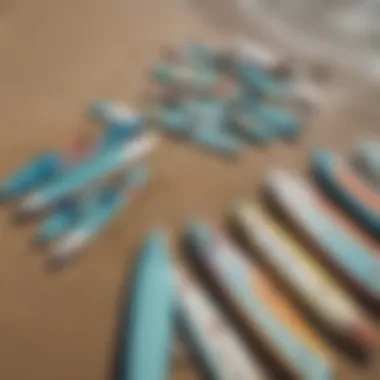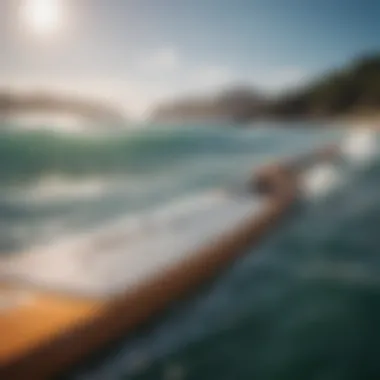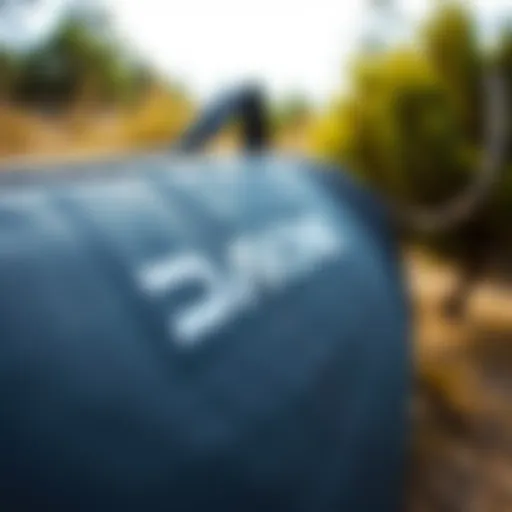Exploring Top Sea Paddle Boards for Enthusiasts


Intro
Paddle boarding has risen to become a beloved pastime for many, blending relaxation with an adventure across lakes, rivers, and the sea. But to truly enjoy your time on the water, you need the right gear. This guide aims to break down the specifics of sea paddle boards, which have special designs and features tailored for different water conditions.
Rather than simply tossing a board on the roof of your car on a whim, it’s essential to consider various elements that come into play. Material, sizing, and intended use can all vary wildly among paddle boards, impacting both performance and enjoyment. Whether you’re just dipping your toes into the paddling world or are a seasoned enthusiast seeking upgrades, there's plenty here to learn.
Surf Gear and Equipment
Understanding your gear can have a significant impact on your experience out on the water. Sea paddle boards, in particular, require a keen sense of what makes them different from standard boards you might find in calmer waters. Let’s dive deeper into the specifics, starting with some of the latest developments in surfboard technology.
Latest Surfboard Technologies
- Material Innovations: Modern boards often utilize advanced materials like carbon fiber or high-density foam, which not only enhance durability but also improve buoyancy and speed. This means you can glide over waves with greater ease.
- Stability Features: Many boards now come equipped with wider designs and specialized hull shapes, which contribute to better stability—crucial when navigating choppy waters.
- Inflatable Models: Inflatable boards are a game-changer for portability. Their construction allows for easy transport while maintaining sufficient toughness against everyday impacts.
- Smart Technologies: Some brands are now introducing integrated GPS systems into their boards. These features can track your distance, speed, and even offer safety alerts if you drift too far from a designated area.
Essential Accessories for Surfers
While a well-chosen board is foundational, the right accessories can enhance your visit to the sea. Consider the following essentials:
- Leash: An often-overlooked item, a leash keeps your board attached to you, preventing it from drifting away should you take an unexpected tumble.
- Paddle: The right paddle makes all the difference. Look for a lightweight, adjustable paddle to facilitate ease in maneuvering.
- Personal Flotation Device: Always prioritize safety by wearing a PFD, even if you're a confident swimmer.
- Dry Bag: Protect your belongings from splashes and waves by using a waterproof dry bag.
"The right gear is more than just tools; it’s your ticket to an enjoyable experience on the water."
Overall, investing in quality equipment significantly enhances the paddle boarding experience and helps to ensure both safety and performance.
Techniques and Skills
Mastering your board also requires a solid grasp of techniques and skills applicable to paddle boarding. Whether you're looking to ride the waves or just enjoy a leisurely glide across the water, here are some strategies and safety tips to consider.
Wave Riding Strategies
When hitting the surf, it’s important to understand how waves work. To get the most out of your experience:
- Position Yourself Correctly: Arrive at the right spot where the wave breaks. Standing too far inside the lineup might make it difficult to catch waves consistently.
- Timing is Key: Paddling at the right moment can be the difference between riding a wave or getting caught behind it. Aim to enter the wave as it starts to form.
- Body Positioning: Keep your weight centered and lower your stance to maintain balance while riding.
Safety and Surf Etiquette
Every surfer should prioritize safety and learn the unwritten rules of the water:
- Respect Local Rules: Every surf spot has its norms. Be attentive to fellow surfers and follow local guidelines.
- Keep Distance: Maintain a safe distance from other surfers to prevent collisions.
- Know Your Limits: It’s important to recognize when the conditions are beyond your skill level.
In summary, paddle boarding is not just about the board you choose, but also about honing your skills and understanding the dynamics of the water. By being equipped with the right gear and knowledge, you can elevate your paddle boarding experience to one that is not only thrilling but safe.
Understanding Sea Paddle Boards
Grasping the concept of sea paddle boards serves as the bedrock for anyone looking to venture into this thrilling water sport. Unlike your average paddle boards, which might be more suited for calm lakes or rivers, sea paddle boards are specially designed to handle the sometimes unpredictable conditions of the ocean. This not only enhances safety but also elevates the overall experience of paddling through waves and currents. If you’re willing to venture beyond the traditional, understanding the nuances is crucial.
When we delve deeper into the essence of sea paddle boards, a few specific elements stand out. From the board’s shape and size to the materials that ensure durability against saltwater and sun exposure, every facet plays a vital role. Moreover, these boards often come with features that cater to the unique needs of sea conditions, such as increased buoyancy or streamlined designs to cut through water more efficiently.
Defining Sea Paddle Boards
Sea paddle boards are essentially wider and longer than their counterparts, primarily built for stability and navigation in ocean waters. Typically, these boards range anywhere from 10 to 14 feet in length and 30 to 36 inches in width. This design not only accommodates the fluctuating waves but also assures a comfortable ride. The broader base allows users to keep their balance while paddling in ocean waves, providing a sense of security that is often lacking in narrower boards.
The materials used are also critical in defining these boards. Many are constructed from materials like epoxy or fiberglass, often layered over a foam core, granting both durability and lightness. These attributes mean that even a novice paddler can manage such boards with ease, enabling an enjoyable and safe sea experience.
Key Differences from Other Types of Paddle Boards
While comparing sea paddle boards to other types, two main distinctions highlight their unique features: design and intended use.
- Design: Sea paddle boards often have a pointed nose, which helps in slicing through waves, whereas all-around boards typically have a more rounded tip for versatility in flat waters. This taper allows for a more efficient glide, helping users to paddle longer distances with less effort.
- Intended Use: Sea paddle boards are tailored for ocean adventures, making them suitable for longer journeys than simply enjoying a tranquil paddle on a lake. This is crucial for enthusiasts who want to challenge themselves against elements like wind and current.
When you consider these distinctions, it becomes clear that selecting the right paddle board impacts not just performance, but also your enjoyment and safety on the water.


"Choosing the correct paddle board can transform your experience from ordinary to extraordinary, especially on the open seas."
Whether you’re a thrill-seeker or someone looking to relax while exploring beautiful coastlines, understanding the specific characteristics of sea paddle boards is essential. Armed with this knowledge, you can navigate the market with confidence, ensuring that your choice aligns with your aspirations on the water.
Essential Features to Consider
When it comes to sea paddle boards, understanding the essential features is paramount for anyone looking to make an informed choice. Each element plays a distinctive role in driving the overall performance and experience on the water. These features should not be overlooked because they significantly impact factors like stability, speed, and how enjoyable your time on the water is. Here’s a closer look at what to consider:
Dimensions and Weight Capacity
Dimensions are a critical factor that dictates how a paddle board behaves in the water. The length, width, and thickness contribute to the board’s buoyancy and handling. For instance, longer boards generally provide more speed and tracking, making them ideal for touring, while shorter boards are easier to maneuver and suit those looking to surf.
Weight capacity is just as important. When choosing a board, assess your weight and any additional gear you’ll be carrying. Exceeding the weight capacity can lead to poor performance and stability. A board should sit high enough in the water to allow efficient paddling. As a benchmark, a board that can support 250 pounds might be suitable for a paddler weighing 180 pounds along with gear.
Material Quality and Durability
The material of a paddle board can greatly influence its durability and performance. Common materials include epoxy for hard boards and inflatable PVC for those that can be deflated. Each has its strengths and weaknesses.
- Epoxy Boards: These are typically rigid, light, and offer great performance on the water. However, they can suffer damage if collided with sharp objects.
- Inflatable Boards: These are highly durable due to the nature of their construction. They're resistant to dents and dings, making them suitable for rocky waters. Plus, they can be easily stored and transported.
A paddle board with robust material quality guarantees longevity. Investing in a product that stands the test of time pays off in the long run, allowing you to enjoy your adventures without constant repairs or replacements.
Design Considerations for Stability and Performance
A well-designed paddle board strikes a balance between stability and performance. You want a board that feels steady but also enables swift movement. For stability, consider the board's width and shape. A wider board gives more balance, making it ideal for beginners or those who enjoy a leisurely paddle. Conversely, a narrower design enhances speed, which is advantageous for experienced paddlers chasing performance.
To illustrate:
- Flat Bottom vs. Rockered Designs: Flat bottoms increase stability, ideal for calm waters, while rockered designs aid in maneuverability which is great for choppy conditions or surf.
- Fin Setup: A board with a single fin setup provides smooth tracking, whereas multiple fins help in sharper turns, particularly useful when navigating tight spaces.
Choosing a paddle board with thoughtful design elements ensures a better paddling experience, making each outing more enjoyable.
It's essential to do your research and weigh these factors based on your personal experience and the environments you'll be paddling in.
In summary, when exploring your options in sea paddle boards, understanding dimensions and weight capacity, material quality and durability, as well as design considerations can make all the difference in your adventure. Ensuring that you choose wisely means you'll be paddling with confidence, whether you're skimming over calm waters or confronting waves.
Types of Sea Paddle Boards
Understanding the different types of sea paddle boards is essential for anyone serious about getting into paddle boarding. Each type serves a specific purpose and caters to various activities, preferences, and environments. By distinguishing between these boards, paddle boarders can enhance their experience whether they're cruising along a shoreline, racing against friends, or trying to catch a fresh meal.
All-Around Paddle Boards
All-around paddle boards are the Swiss Army knives of the paddle boarding world. They are designed for versatility and can handle a mix of activities like leisurely paddling, mild wave riding, and even simple fishing excursions. Typically wider and more stable than racing or touring boards, they are perfect for beginners who are just starting their journey or families looking to enjoy time on the water together.
Some notable features include:
- Stability: Their wider shape provides balance, which is crucial for newcomers.
- Length: Usually between 10-12 feet, making them manageable in various water conditions.
- Weight Capacity: Suitable for a range of paddlers, often supporting heavier loads for additional gear.
This type of board allows for a casual exploration of the coastal waters without needing to specialize in one particular paddling discipline.
Touring Paddle Boards
If you're the type who loves to explore longer distances and has a penchant for adventure, touring paddle boards may be your best friend. These boards are designed for efficiency and speed, making them ideal for long treks on open water. Generally ranging from 12 to 14 feet in length, they cut through water effectively and maintain a straight trajectory, reducing the need for constant paddling adjustments.
Key characteristics include:
- Narrower Design: This promotes straight-line tracking and speed but requires good balance.
- Storage Options: Many come with bungee cords or dedicated compartments, perfect for stowing snacks or gear.
- Enhanced Performance: Their shape allows for a smoother glide, making them suitable for long sessions on the water.
For those who want to explore not just the water, but all that it has to offer across longer distances, touring boards deliver an experience like no other.
Racing Paddle Boards
Next up are racing paddle boards. These are specialized for speed and performance, crafted for the competitive spirit. These boards are generally narrower and longer (14 feet and up), cutting through the water like a knife. If the thrill of competition excites you, or if you simply want to paddle faster than your friends, these boards are your ticket.


Their standout features typically include:
- Streamlined Shape: Reduces drag, enhances speed, and improves maneuverability.
- Lightweight Materials: Often made from high-end composites, which results in quicker acceleration.
- Designed for Competition: Features like handles and a tri-fin setup can help advanced paddlers prepare for events.
Choosing a racing paddle board involves serious consideration of your goals and competitive spirit, as the right equipment can give you the edge.
Fishing Paddle Boards
Lastly, let's not forget about the fishing paddle boards. If you're someone who relishes the serenity of the seas while trying to reel in a catch, these boards are specifically tailored for fishing enthusiasts. They come with features that make fishing easier and more enjoyable, whether you’re navigating still lakes or surfcasting off the coast.
Look out for:
- Stable Design: Wider dimensions to provide a stable platform for standing and casting.
- Rod Holders: Built-in or attachable rod holders ensure you can multi-task without losing your gear.
- Storage Space: Enough room to stow away bait, tackle boxes, or camping gear for an extended outing.
Fishing paddle boards offer a unique way to combine the love of paddle boarding with chasing after fish, allowing for a peaceful day on the water.
"Selecting the right type of paddle board can make or break your experience on the water. Whether you're racing, fishing, or just enjoying some leisurely paddling, find the board that fits your needs."
Each type of sea paddle board has its own unique benefits and features. Your choice should reflect your interests, skill level, and the conditions in which you'll be paddling. Whether it’s versatility, speed, or functionality at play, understanding these distinctions is paramount to ensure your time on the water is both enjoyable and productive.
Top Sea Paddle Boards on the Market
When it comes to sea paddle boarding, having the right gear can make all the difference in how you experience the water. The market is bustling with options, and understanding what sets the best sea paddle boards apart is crucial for any surfer or water enthusiast. This section dives into the readily available choices, offering insights into their unique features, benefits, and the specific considerations that should guide your decision-making.
Choosing the right paddle board not only impacts your performance but also your safety and enjoyment on the water. The right board can enhance stability, improve maneuverability, and cater to your specific paddle boarding style, whether it's fishing, touring, or racing. Thus, getting acquainted with the top contenders in the market is essential for making an informed purchase.
Comparative Analysis of Leading Brands
In the sea paddle boarding landscape, a few brands consistently garner attention due to their reputation for quality and innovation. Let’s take a closer look at some of these leading players:
- Red Paddle Co: Known for its inflatable boards, Red Paddle Co is often hailed for integrating cutting-edge design with durability. Their boards are lightweight yet strong, frequently praised for their stability on rough waters.
- BIC Sport: BIC combines affordability with performance. Their boards cater well to beginners and experienced paddle boarders alike, often notable for their sturdy construction.
- Starboard: A household name among enthusiasts, Starboard offers a range of boards tailored for different types of paddle boarding. Their commitment to sustainability adds an extra layer of appeal to eco-conscious consumers.
- Naish: This brand boasts a premium line of boards crafted for those looking for speed and agility. The Naish boards often feature advanced materials for performance on competitive waters.
Each brand brings something unique to the table, from innovative shapes and sizes to specialized technologies. It’s essential to consider what type of paddling you intend to engage in and align it with a brand’s strengths.
User Reviews and Experiences
A wealth of knowledge often lies within the reviews and experiences shared by fellow paddle boarders. Reading through user feedback can unveil insights that statistics alone fail to convey. Here are a few key takeaways:
- Real-World Performance: Customers often share their stories about how a board performs in actual conditions, providing context beyond the manufacturers' claims. This can be especially instructional when it comes to understanding how a board handles choppy waters versus calmer ones.
- Durability Insights: Some users report their experiences with the longevity of their boards. Real-world usage often tests the manufacturer's promises. Information regarding usage over time, and any damage encountered is invaluable.
- User Fitness Levels: Feedback typically reveals how accessible a board is to varying skill levels. For instance, some experienced users might find a board too limiting during aggressive paddling, while beginners might appreciate the same board’s forgiving nature.
- Customer Support: Often overlooked, a brand's customer service can make or break the purchasing experience. Insights into how brands handle issues post-purchase can guide potential customers towards more reliable choices.
Listening to fellow surfers on platforms like Reddit or dedicated paddle boarding forums can offer a rich tapestry of experiences that highlight the strengths and weaknesses of specific boards. Gathering this information will not only aid in making a more informed decision but also steer you towards a paddle board that aligns with your needs.
"The best paddle board isn’t necessarily the most expensive one; it’s the one that matches your style and keeps you enjoying time on the water."
Selecting the Right Paddle Board for You
Choosing the proper paddle board is like finding the right shoes for a long trek; you wouldn’t want blisters on your journey. This selection is vital because it directly influences how much you enjoy your time on the water. People often underestimate the importance of assessing their personal needs and the local conditions before making a purchase. A well-chosen board can make the difference between a delightful day out paddling and a frustrating struggle against the waves or winds.
Evaluating Your Skill Level and Experience
Understanding one’s skill level is crucial in the selection process. For beginners, an all-around paddle board may be an excellent choice due to its versatility and stability. A novice might feel overwhelmed on a racing board, designed for speed and agility, where misjudgments can have uncomfortable outcomes.
- Beginner: If you’re starting out, look for wider boards. They provide better balance. Brands like BIC Sport and iROCKER are known for their user-friendly boards.
- Intermediate: If you have some experience, perhaps a touring board might be appealing. These types are longer and cut through the water more effectively, which will excite your inner adventurer.
- Advanced: Advanced paddlers might gravitate towards racing boards, which offer speed but require a good understanding of water conditions and paddle techniques.
Identifying your proficiency level enables you to narrow down options effectively. It often pays off to rent or borrow different styles before committing to a purchase.
Assessing Local Waters and Conditions
Understanding the waters where you’ll be paddling is just as important as knowing your skill level. Different locations come with varying conditions that can significantly affect your experience.
- Flatwater Lakes: If you live close to calm waters, a touring board is appropriate, letting you glide peacefully.
- Rivers with Currents: For those near rivers, a board designed to handle challenging flows will keep you stable and safe.
- Ocean Settings: Going into rough seas calls for boards built for stability and maneuverability


Factors like wind, tides, and wave size will also play a crucial role. For instance, it’s wise to check local forecasts without fail and select a board that matches not just the day’s conditions but also the typical environment.
"Selecting a paddle board involves understanding not only your skills but the element you plan to explore. It’s a dance between personal ability and nature’s whims."
Maintenance and Care
Taking care of your sea paddle board is akin to nurturing a fine instrument; not only does proper maintenance enhance its performance, but it also extends its lifespan significantly. By adhering to a few essential practices, you ensure that your investment remains in prime condition for all your water adventures. Moreover, paddle boards have their own particular quirks, and understanding them is crucial to getting the most out of your time on the water. This section dives into the nitty-gritty of maintenance and care, shedding light on why it's indispensable for paddlers of all skill levels.
Cleaning and Storage Guidelines
Cleaning your paddle board after every use is more than just a suggestion; it’s a vital step. When you haul your board in and out of the water, it picks up sand, salt, and grime. If left unchecked, these particles can scratch the surface or cause long-term deterioration. A simple rinse with fresh water will do wonders, washing away remnants of the sea.
Here are some tips to keep your board squeaky clean:
- Rinse Immediately: Right after you paddle, rinse the board with fresh water to remove salt and sand.
- Use Mild Soaps: If your board is particularly dirty, a little gentle soap and a soft sponge can take care of stubborn spots. Avoid harsh chemicals that can damage the board.
- Inspect for Damage: While cleaning, take a moment to inspect your board for scratches or dings. Early detection can save you a lot of trouble down the road.
- Proper Storage: After cleaning, store your paddle board indoors in a cool, dry place, away from direct sunlight. If you must keep it outside, use a conventional board bag or cover to shield it from elements.
"Routine cleaning might seem minor, yet it's a paddle board owner's best friend in preserving quality."
Repairing Damage
Eventually, even with the best care, your paddle board may suffer minor scratches or dings. These blemishes might appear harmless, but ignoring them can lead to larger issues like water leaking into the core material. Knowing how to repair them can be a game-changer.
Here are a few key points to consider for repairing damage:
- DIY Repairs: For minor dings, a paddle board repair kit can be incredibly useful. These kits often come with resin and sandpaper, allowing you to fill and smooth out imperfections easily.
- Seek Professional Help: If the damage is extensive or beyond your skill set, don't hesitate to contact a professional repair service. Getting expert help might seem costly, but it’s often cheaper than replacing the board entirely.
- Prevention is Key: Always use proper technique when carrying and storing your board. Avoid dropping or dragging it over rough surfaces to minimize the chances of damage occurring in the first place.
Taking meticulous care of your sea paddle board ensures that you can wander the waves without worry. Clean it, store it right, and don’t skimp on repairs, and your board will be serving you well for many seasons to come.
Safety and Environmental Considerations
When it comes to paddle boarding, safety and environmental considerations are critical. Engaging with water and nature offers immense joy, but it also comes with responsibilities. A focus on safety not only protects you, but also enhances the overall experience for everyone involved, creating a more enjoyable environment. Simultaneously, thinking about how our activities impact the world around us is equally crucial—especially as paddle boarders often engage with delicate ecosystems.
Paddle Boarding Safety Tips
Safety doesn’t happen by accident, especially on the water. Here are some tips to keep in mind:
- Wear a Personal Flotation Device (PFD): While it might feel cumbersome, having a buoyancy aid on board can be a lifesaver. It's not just about feeling secure; it’s the law in many places too.
- Check Weather Conditions: Before embarking on your paddle, it’s wise to look out for weather forecasts. Sudden storms can turn a serene experience into a perilous situation in no time.
- Stay Hydrated and Energized: It’s crucial to keep your energy levels up. Bring enough water and snacks. You don’t want to run out halfway through your adventure!
- Practice Good Communication: If you’re paddling with friends, establish a signaling method. This can be invaluable in case someone needs assistance.
- Familiarize Yourself with Your Board: Knowing how your specific board responds in various conditions can make a significant difference. Spend time practicing in calm waters before tackling rougher waves.
"Safety is not a gadget, but a state of mind." - Eleanor Everet
Eco-Friendly Practices for Paddle Board Users
Being a responsible paddle boarder means considering the ecosystems that we thrive in. Here are some ways to ensure you leave a positive impact:
- Avoid Disturbing Wildlife: Paddle quietly and steer clear of areas where animals nest. It’s essential to respect local wildlife.
- Pick Up After Yourself: Always take your trash with you. Even the smallest piece of litter can significantly affect marine life. Use reusable bags for gear, and carry a small trash bag to dispose of any waste you may generate while out.
- Use Eco-Friendly Products: If you’re using wax or cleaners for your equipment, look for biodegradable options. Protecting the water reflects a commitment to preserving it.
- Participate in Clean-Up Events: Many communities host beach clean-up days. Getting involved not only benefits the environment but also creates a sense of community among paddle boarders.
By adhering to these guidelines, paddle boarders can create not only a safer experience for themselves but also a cleaner, more sustainable environment for everyone to enjoy.
The Future of Sea Paddle Boarding
The realm of sea paddle boarding is evolving faster than a tidal wave crashing onto the shore. With the growing popularity of this activity, enthusiasts and manufacturers alike are paying more attention to what lies ahead. The future holds the potential for innovations that could redefine our paddle boarding experience, ensuring both performance and compatibility with environmental needs. In this section, delving into upcoming technological developments and the sustainability movement provides vital perspectives for any sea paddle boarder wishing to stay ahead of the game.
Innovations and Technological Developments
Paddle boards have come a long way from the simple wooden planks of yesteryears. Today, technology plays an indispensable role in enhancing performance and user experience.
- Lightweight Materials: Many manufacturers are now leaning towards lighter yet robust materials such as carbon fiber and advanced composites. This shift doesn’t just make boards easier to handle, but it also improves overall performance on the water.
- Smart Technology: Imagine integrating GPS tracking, speed monitoring, or even performance analytics right into the paddle itself. These advancements can help users track their progress and provide feedback on how to improve.
- Inflatable Innovations: Inflatable paddle boards have hit the mainstream, and for good reason. These boards are not only portable, allowing for easy transport and storage, but many models now rival traditional rigid boards in terms of performance and durability.
- Eco-Friendly Technologies: With more brands prioritizing sustainability, there’s a push for boards created from recycled materials or using environmentally sound manufacturing processes. This trend is likely to gain traction as consumers become more eco-conscious.
"As the popularity of sea paddle boarding grows, embracing innovative technologies can lead to a safer and more enjoyable experience for all."
Embracing these innovations not only enhances the user experience but also engages a wider audience, promoting paddle boarding as an accessible sport to many.
The Growing Influence of Sustainability in Surfboarding
The buzz around sustainability is not just a passing trend; it’s a revolution in mindset. Paddle boarders are becoming increasingly aware of their ecological footprint while enjoying the great outdoors. Here’s what this shift says about the future:
- Conservation Initiatives: Many paddle boarding brands are aligning themselves with conservation groups, ensuring that their products contribute towards preserving our oceans and waterways. Through collaborations like these, there’s a clear effort to clean beaches and protect aquatic life.
- Informed Consumer Choices: Shoppers are now looking for brands that resonate with their values. Choosing eco-friendly, sustainably sourced boards is seen not just as a smart choice, but a necessary one. As a result, companies that promote transparent sourcing and environmental ethics are gaining more traction in the market.
- Awareness Campaigns: Social media platforms and community events are vital in raising awareness about the importance of preserving marine environments. Engaging stories and visuals shared on platforms like Reddit and Facebook show how the paddle boarding community is rallying around ocean health.
Sustainability is undoubtedly shaping the future of paddle boarding, pushing pioneers to innovate while being mindful of their impact. This transition not only enriches the paddling experience but also ensures that future generations can enjoy the beauty of our waters.















